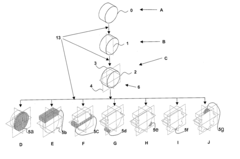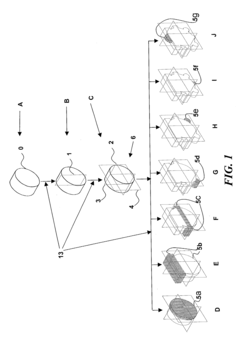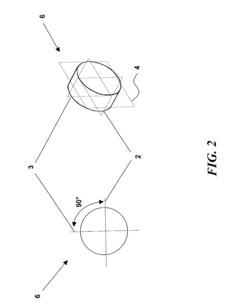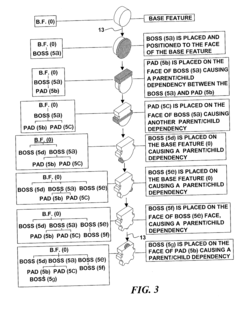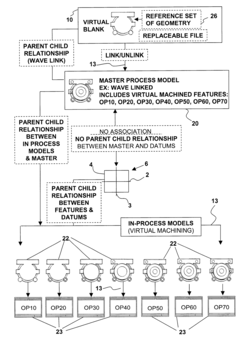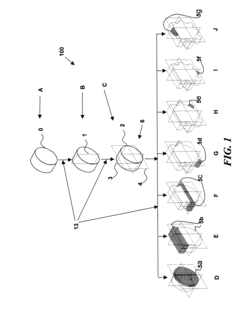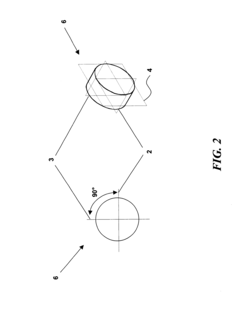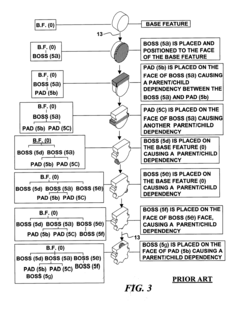The Strategic Role of Accura 25 in Tooling Applications
JUL 8, 20259 MIN READ
Generate Your Research Report Instantly with AI Agent
Patsnap Eureka helps you evaluate technical feasibility & market potential.
Accura 25 Background
Accura 25 is a groundbreaking stereolithography (SLA) resin developed by 3D Systems, specifically designed for tooling applications in various industries. This innovative material has its roots in the early 2000s when the demand for high-performance, durable, and heat-resistant 3D printing materials began to surge in the manufacturing sector.
The development of Accura 25 was driven by the need for a material that could withstand the rigorous demands of tooling applications, particularly in industries such as automotive, aerospace, and consumer goods manufacturing. Traditional tooling methods often involved time-consuming and costly processes, creating a market opportunity for advanced 3D printing materials that could offer faster turnaround times and reduced costs.
Accura 25 emerged as a solution to these challenges, offering a unique combination of properties that make it ideal for tooling applications. Its high heat deflection temperature, excellent dimensional stability, and superior surface finish set it apart from conventional 3D printing materials. These characteristics enable the production of tools and molds that can withstand the high temperatures and pressures associated with various manufacturing processes.
The material's evolution has been closely tied to advancements in stereolithography technology. As SLA printers became more precise and capable of producing larger parts, Accura 25 was refined to take full advantage of these improvements. This synergy between material and machine has been crucial in expanding the potential applications of 3D printed tooling.
Over the years, Accura 25 has undergone several iterations to enhance its performance and versatility. These improvements have focused on increasing its temperature resistance, improving its mechanical properties, and optimizing its compatibility with different post-processing techniques. The result is a material that can be used for a wide range of tooling applications, from prototype molds to production-ready tools.
The strategic importance of Accura 25 in the tooling industry cannot be overstated. It has played a pivotal role in accelerating product development cycles, reducing time-to-market for new products, and enabling more cost-effective small-batch production runs. By allowing manufacturers to quickly produce complex tooling geometries that would be challenging or impossible with traditional methods, Accura 25 has opened up new possibilities for design innovation and manufacturing efficiency.
As the manufacturing landscape continues to evolve, with a growing emphasis on customization and rapid iteration, materials like Accura 25 are becoming increasingly critical. They represent a shift towards more agile and responsive manufacturing processes, aligning with the broader trends of Industry 4.0 and smart manufacturing. The ongoing development and refinement of Accura 25 reflect the dynamic nature of the tooling industry and the continuous drive for materials that can meet the ever-changing demands of modern manufacturing.
The development of Accura 25 was driven by the need for a material that could withstand the rigorous demands of tooling applications, particularly in industries such as automotive, aerospace, and consumer goods manufacturing. Traditional tooling methods often involved time-consuming and costly processes, creating a market opportunity for advanced 3D printing materials that could offer faster turnaround times and reduced costs.
Accura 25 emerged as a solution to these challenges, offering a unique combination of properties that make it ideal for tooling applications. Its high heat deflection temperature, excellent dimensional stability, and superior surface finish set it apart from conventional 3D printing materials. These characteristics enable the production of tools and molds that can withstand the high temperatures and pressures associated with various manufacturing processes.
The material's evolution has been closely tied to advancements in stereolithography technology. As SLA printers became more precise and capable of producing larger parts, Accura 25 was refined to take full advantage of these improvements. This synergy between material and machine has been crucial in expanding the potential applications of 3D printed tooling.
Over the years, Accura 25 has undergone several iterations to enhance its performance and versatility. These improvements have focused on increasing its temperature resistance, improving its mechanical properties, and optimizing its compatibility with different post-processing techniques. The result is a material that can be used for a wide range of tooling applications, from prototype molds to production-ready tools.
The strategic importance of Accura 25 in the tooling industry cannot be overstated. It has played a pivotal role in accelerating product development cycles, reducing time-to-market for new products, and enabling more cost-effective small-batch production runs. By allowing manufacturers to quickly produce complex tooling geometries that would be challenging or impossible with traditional methods, Accura 25 has opened up new possibilities for design innovation and manufacturing efficiency.
As the manufacturing landscape continues to evolve, with a growing emphasis on customization and rapid iteration, materials like Accura 25 are becoming increasingly critical. They represent a shift towards more agile and responsive manufacturing processes, aligning with the broader trends of Industry 4.0 and smart manufacturing. The ongoing development and refinement of Accura 25 reflect the dynamic nature of the tooling industry and the continuous drive for materials that can meet the ever-changing demands of modern manufacturing.
Market Demand Analysis
The market demand for Accura 25 in tooling applications has been steadily growing, driven by the increasing need for high-performance, rapid prototyping solutions in various industries. This photopolymer resin, developed by 3D Systems, has gained significant traction due to its exceptional properties that closely mimic those of engineering-grade thermoplastics.
In the automotive sector, Accura 25 has seen a surge in demand for creating functional prototypes and tooling components. The material's ability to withstand high temperatures and its dimensional stability make it ideal for producing molds, jigs, and fixtures used in automotive manufacturing processes. This has led to reduced lead times and costs associated with traditional tooling methods.
The aerospace industry has also shown increased interest in Accura 25 for tooling applications. The material's resistance to chemicals and its high stiffness make it suitable for creating complex geometries and intricate parts used in aircraft design and testing. As the aerospace sector continues to push for lighter and more efficient components, the demand for advanced tooling materials like Accura 25 is expected to grow.
Consumer electronics manufacturers have embraced Accura 25 for rapid prototyping and small-scale production tooling. The material's smooth surface finish and ability to capture fine details make it particularly valuable in creating molds for consumer electronic devices and their components. This has enabled faster product development cycles and more efficient design iterations.
The medical device industry has also recognized the potential of Accura 25 in tooling applications. Its biocompatibility and sterilization capabilities make it suitable for creating molds and fixtures used in the production of medical devices and surgical instruments. As the healthcare sector continues to innovate, the demand for advanced tooling materials is expected to increase.
Market analysis indicates that the global 3D printing materials market, which includes Accura 25, is projected to grow significantly in the coming years. The tooling segment within this market is expected to experience substantial growth, driven by the increasing adoption of additive manufacturing technologies across various industries.
The demand for Accura 25 is also influenced by the growing trend towards sustainable manufacturing practices. Its ability to reduce material waste and energy consumption compared to traditional tooling methods aligns with the sustainability goals of many companies, further driving its adoption in tooling applications.
As industries continue to seek ways to optimize their production processes and reduce time-to-market, the demand for advanced materials like Accura 25 in tooling applications is expected to remain strong. The material's versatility, combined with its ability to meet the stringent requirements of various industries, positions it as a key player in the evolving landscape of additive manufacturing and rapid prototyping.
In the automotive sector, Accura 25 has seen a surge in demand for creating functional prototypes and tooling components. The material's ability to withstand high temperatures and its dimensional stability make it ideal for producing molds, jigs, and fixtures used in automotive manufacturing processes. This has led to reduced lead times and costs associated with traditional tooling methods.
The aerospace industry has also shown increased interest in Accura 25 for tooling applications. The material's resistance to chemicals and its high stiffness make it suitable for creating complex geometries and intricate parts used in aircraft design and testing. As the aerospace sector continues to push for lighter and more efficient components, the demand for advanced tooling materials like Accura 25 is expected to grow.
Consumer electronics manufacturers have embraced Accura 25 for rapid prototyping and small-scale production tooling. The material's smooth surface finish and ability to capture fine details make it particularly valuable in creating molds for consumer electronic devices and their components. This has enabled faster product development cycles and more efficient design iterations.
The medical device industry has also recognized the potential of Accura 25 in tooling applications. Its biocompatibility and sterilization capabilities make it suitable for creating molds and fixtures used in the production of medical devices and surgical instruments. As the healthcare sector continues to innovate, the demand for advanced tooling materials is expected to increase.
Market analysis indicates that the global 3D printing materials market, which includes Accura 25, is projected to grow significantly in the coming years. The tooling segment within this market is expected to experience substantial growth, driven by the increasing adoption of additive manufacturing technologies across various industries.
The demand for Accura 25 is also influenced by the growing trend towards sustainable manufacturing practices. Its ability to reduce material waste and energy consumption compared to traditional tooling methods aligns with the sustainability goals of many companies, further driving its adoption in tooling applications.
As industries continue to seek ways to optimize their production processes and reduce time-to-market, the demand for advanced materials like Accura 25 in tooling applications is expected to remain strong. The material's versatility, combined with its ability to meet the stringent requirements of various industries, positions it as a key player in the evolving landscape of additive manufacturing and rapid prototyping.
Technical Challenges
Accura 25, a stereolithography resin developed by 3D Systems, faces several technical challenges in its application for tooling. One of the primary issues is the material's thermal stability at elevated temperatures. While Accura 25 offers improved heat resistance compared to many conventional resins, it still struggles to maintain its structural integrity and dimensional accuracy when exposed to high-temperature environments often encountered in tooling applications.
Another significant challenge lies in the material's long-term durability. Tooling applications typically require materials that can withstand repeated use and cyclic loading without significant degradation. Accura 25, despite its enhanced properties, may still exhibit limitations in terms of wear resistance and fatigue strength, potentially leading to reduced tool life and increased maintenance requirements.
The surface finish of parts produced using Accura 25 presents another technical hurdle. While the material can achieve relatively smooth surfaces, it may not meet the stringent surface quality demands of certain tooling applications without additional post-processing. This can increase production time and costs, potentially offsetting some of the advantages offered by the rapid prototyping capabilities of stereolithography.
Dimensional accuracy and stability over time pose additional challenges. Although Accura 25 demonstrates improved dimensional stability compared to many other resins, it may still experience some degree of warpage or distortion, particularly in larger or more complex tooling geometries. This can lead to issues with fit, function, and overall tool performance.
The material's chemical resistance is another area of concern. While Accura 25 offers good resistance to many common chemicals, it may still be susceptible to degradation when exposed to certain aggressive substances or solvents used in manufacturing processes. This limitation can restrict its applicability in certain tooling environments or require additional protective measures.
Lastly, the integration of Accura 25 into existing manufacturing workflows presents its own set of challenges. Many traditional tooling processes and equipment are not optimized for additive manufacturing materials like Accura 25. Adapting these processes to fully leverage the benefits of the material while maintaining production efficiency and quality standards requires significant research and development efforts.
Addressing these technical challenges is crucial for expanding the strategic role of Accura 25 in tooling applications. Ongoing research and development efforts are focused on enhancing the material's thermal properties, improving its long-term durability, refining surface finish capabilities, and developing new post-processing techniques to overcome these limitations and unlock the full potential of Accura 25 in advanced tooling solutions.
Another significant challenge lies in the material's long-term durability. Tooling applications typically require materials that can withstand repeated use and cyclic loading without significant degradation. Accura 25, despite its enhanced properties, may still exhibit limitations in terms of wear resistance and fatigue strength, potentially leading to reduced tool life and increased maintenance requirements.
The surface finish of parts produced using Accura 25 presents another technical hurdle. While the material can achieve relatively smooth surfaces, it may not meet the stringent surface quality demands of certain tooling applications without additional post-processing. This can increase production time and costs, potentially offsetting some of the advantages offered by the rapid prototyping capabilities of stereolithography.
Dimensional accuracy and stability over time pose additional challenges. Although Accura 25 demonstrates improved dimensional stability compared to many other resins, it may still experience some degree of warpage or distortion, particularly in larger or more complex tooling geometries. This can lead to issues with fit, function, and overall tool performance.
The material's chemical resistance is another area of concern. While Accura 25 offers good resistance to many common chemicals, it may still be susceptible to degradation when exposed to certain aggressive substances or solvents used in manufacturing processes. This limitation can restrict its applicability in certain tooling environments or require additional protective measures.
Lastly, the integration of Accura 25 into existing manufacturing workflows presents its own set of challenges. Many traditional tooling processes and equipment are not optimized for additive manufacturing materials like Accura 25. Adapting these processes to fully leverage the benefits of the material while maintaining production efficiency and quality standards requires significant research and development efforts.
Addressing these technical challenges is crucial for expanding the strategic role of Accura 25 in tooling applications. Ongoing research and development efforts are focused on enhancing the material's thermal properties, improving its long-term durability, refining surface finish capabilities, and developing new post-processing techniques to overcome these limitations and unlock the full potential of Accura 25 in advanced tooling solutions.
Current Accura 25 Apps
01 Pharmaceutical compositions containing Accura 25
Accura 25 is used in various pharmaceutical compositions for treating different medical conditions. These compositions may include additional active ingredients or excipients to enhance efficacy or improve delivery.- Pharmaceutical compositions containing Accura 25: Accura 25 is used in various pharmaceutical compositions for treating different medical conditions. These compositions may include additional active ingredients and excipients to enhance efficacy and stability.
- Manufacturing processes for Accura 25: Different methods and processes are employed in the production of Accura 25, including synthesis techniques, purification steps, and quality control measures to ensure consistent product quality.
- Analytical methods for Accura 25: Various analytical techniques are used to characterize and quantify Accura 25 in pharmaceutical formulations and biological samples. These methods may include chromatography, spectroscopy, and other advanced analytical tools.
- Formulations containing Accura 25 for specific applications: Accura 25 is incorporated into specialized formulations for targeted applications, such as controlled release systems, topical preparations, or combination therapies with other active ingredients.
- Accura 25 in novel drug delivery systems: Research and development efforts focus on incorporating Accura 25 into innovative drug delivery systems to improve its bioavailability, efficacy, and patient compliance. These may include nanoparticle-based systems, transdermal patches, or other advanced delivery technologies.
02 Chemical synthesis and manufacturing of Accura 25
Methods for synthesizing and manufacturing Accura 25 or related compounds are described. These processes may involve specific reaction conditions, catalysts, or purification techniques to obtain the desired product.Expand Specific Solutions03 Analytical methods for Accura 25
Various analytical techniques and methods are developed for the detection, quantification, and characterization of Accura 25 in different matrices. These may include chromatographic, spectroscopic, or other instrumental methods.Expand Specific Solutions04 Formulations and delivery systems for Accura 25
Different formulations and delivery systems are designed to improve the bioavailability, stability, or targeted delivery of Accura 25. These may include novel dosage forms, controlled release systems, or nanocarriers.Expand Specific Solutions05 Applications of Accura 25 in various industries
Accura 25 finds applications in diverse industries beyond pharmaceuticals, such as agriculture, materials science, or chemical manufacturing. These applications may involve using Accura 25 as a precursor, additive, or functional component in different products or processes.Expand Specific Solutions
Key Industry Players
The strategic role of Accura 25 in tooling applications is evolving within a competitive landscape characterized by rapid technological advancements and growing market demand. The industry is in a mature stage, with established players like Siemens, Robert Bosch, and GM Global Technology Operations leading innovation. The market size is substantial, driven by increasing automation across various sectors. Technological maturity varies, with companies like Kennametal and Virginia Tech Intellectual Properties contributing to ongoing developments. Emerging players such as C2A-Sec and Delphi Technology are introducing novel solutions, intensifying competition and pushing the boundaries of tooling applications.
Robert Bosch GmbH
Technical Solution: Bosch has integrated Accura 25 technology into their advanced manufacturing processes, particularly in the production of high-precision automotive components. The company utilizes Accura 25 in their cutting tools for machining complex engine parts and fuel injection systems. Bosch's implementation focuses on achieving tighter tolerances and superior surface finishes, which are critical for the performance of modern automotive systems[3]. Their tooling strategy with Accura 25 involves optimized cutting geometries and coatings that complement the carbide grade's properties, resulting in enhanced productivity and reduced cycle times in their production lines[4].
Strengths: Improved precision in automotive component manufacturing, increased productivity in high-volume production. Weaknesses: May require significant investment in tooling inventory and potential challenges in adapting existing processes to new tooling.
GM Global Technology Operations LLC
Technical Solution: GM has incorporated Accura 25 technology into their advanced manufacturing processes for producing next-generation vehicle components. The company utilizes Accura 25-based cutting tools in their high-speed machining centers, particularly for processing lightweight alloys and composite materials used in electric vehicle (EV) production. GM's approach focuses on leveraging the superior wear resistance and thermal stability of Accura 25 to achieve consistent part quality and reduce tool changes, which is crucial for maintaining efficiency in their large-scale automotive production facilities[5]. The implementation of Accura 25 tooling has allowed GM to optimize their machining parameters, resulting in improved surface finishes on critical powertrain components and reduced overall manufacturing costs[6].
Strengths: Enhanced efficiency in EV component production, improved part quality, and reduced tooling-related downtime. Weaknesses: Potential challenges in training operators for optimal use of new tooling and initial costs associated with upgrading tooling across multiple production lines.
Accura 25 Innovations
Horizontally structured CAD/CAM coordinate system
PatentInactiveUS20040153296A1
Innovation
- The implementation of a horizontally structured CAD/CAM modeling approach, which employs a 'horizontal tree structure' with exclusive parent/child relationships between reference planes and features, allowing individual features to be added, edited, or deleted independently without affecting the rest of the model, using a base feature and form features with associative relationships to a coordinate system.
Horizontally structured manufacturing process modeling: enhancement to multiple master process models and across file feature operability
PatentInactiveUS6754556B1
Innovation
- The method employs a horizontally structured approach with a master process model and in-process model, allowing individual features to be added, edited, or deleted independently by establishing a parent/child relationship between reference planes and features, enabling changes to one feature without affecting others.
Material Properties
Accura 25 is a high-performance stereolithography resin developed by 3D Systems, specifically designed for tooling applications in various industries. This material exhibits a unique combination of properties that make it particularly suitable for creating durable and precise tooling components.
The mechanical properties of Accura 25 are noteworthy, with a tensile strength of approximately 68-75 MPa and a flexural modulus ranging from 2,900 to 3,100 MPa. These values indicate excellent strength and stiffness, crucial for withstanding the rigors of tooling applications. The material also demonstrates good impact resistance, with a notched Izod impact strength of 25-30 J/m, enhancing its durability in high-stress environments.
Thermal characteristics of Accura 25 are equally impressive. It maintains its structural integrity at elevated temperatures, with a heat deflection temperature (HDT) of around 62-65°C at 0.45 MPa. This thermal stability allows for the creation of tools that can withstand moderate heat exposure during manufacturing processes.
The dimensional accuracy of parts produced using Accura 25 is exceptional, with tolerances as tight as ±0.1mm achievable for most geometries. This precision is critical for tooling applications where exact dimensions and smooth surface finishes are required. The material also exhibits minimal shrinkage during the curing process, typically less than 0.2%, which contributes to its dimensional stability.
Accura 25 demonstrates excellent chemical resistance, particularly against common industrial fluids such as oils, greases, and many solvents. This resistance ensures the longevity of tools exposed to various chemicals during manufacturing processes. Additionally, the material's low moisture absorption rate, typically less than 0.2% over 24 hours, contributes to its dimensional stability in humid environments.
The optical properties of Accura 25 are characterized by its translucent appearance, which can be advantageous in certain tooling applications where visual inspection of internal features is necessary. The material can also be easily finished and painted, allowing for customization and improved aesthetics when required.
In terms of processability, Accura 25 is compatible with a wide range of stereolithography systems, offering flexibility in manufacturing setups. Its cure depth and scanning speed can be optimized to achieve an excellent balance between build speed and part quality, making it suitable for both prototyping and production tooling applications.
The mechanical properties of Accura 25 are noteworthy, with a tensile strength of approximately 68-75 MPa and a flexural modulus ranging from 2,900 to 3,100 MPa. These values indicate excellent strength and stiffness, crucial for withstanding the rigors of tooling applications. The material also demonstrates good impact resistance, with a notched Izod impact strength of 25-30 J/m, enhancing its durability in high-stress environments.
Thermal characteristics of Accura 25 are equally impressive. It maintains its structural integrity at elevated temperatures, with a heat deflection temperature (HDT) of around 62-65°C at 0.45 MPa. This thermal stability allows for the creation of tools that can withstand moderate heat exposure during manufacturing processes.
The dimensional accuracy of parts produced using Accura 25 is exceptional, with tolerances as tight as ±0.1mm achievable for most geometries. This precision is critical for tooling applications where exact dimensions and smooth surface finishes are required. The material also exhibits minimal shrinkage during the curing process, typically less than 0.2%, which contributes to its dimensional stability.
Accura 25 demonstrates excellent chemical resistance, particularly against common industrial fluids such as oils, greases, and many solvents. This resistance ensures the longevity of tools exposed to various chemicals during manufacturing processes. Additionally, the material's low moisture absorption rate, typically less than 0.2% over 24 hours, contributes to its dimensional stability in humid environments.
The optical properties of Accura 25 are characterized by its translucent appearance, which can be advantageous in certain tooling applications where visual inspection of internal features is necessary. The material can also be easily finished and painted, allowing for customization and improved aesthetics when required.
In terms of processability, Accura 25 is compatible with a wide range of stereolithography systems, offering flexibility in manufacturing setups. Its cure depth and scanning speed can be optimized to achieve an excellent balance between build speed and part quality, making it suitable for both prototyping and production tooling applications.
Sustainability Aspects
Accura 25, a high-performance stereolithography resin, plays a significant role in advancing sustainability within tooling applications. This material's unique properties contribute to more efficient and environmentally friendly manufacturing processes, aligning with the growing emphasis on sustainable practices in industry.
One of the primary sustainability benefits of Accura 25 is its ability to reduce material waste. Traditional tooling methods often involve subtractive manufacturing, where excess material is removed to create the final product. In contrast, Accura 25 enables additive manufacturing techniques, allowing for precise creation of complex geometries with minimal material waste. This not only conserves resources but also reduces the environmental impact associated with material disposal.
The durability and longevity of Accura 25 tools further enhance their sustainability profile. These tools can withstand repeated use and maintain their dimensional accuracy over extended periods, reducing the need for frequent replacements. This longevity translates to fewer resources consumed in tool production and less waste generated from discarded tools, contributing to a more sustainable manufacturing ecosystem.
Energy efficiency is another crucial aspect of Accura 25's sustainability credentials. The stereolithography process used with this resin typically requires less energy compared to traditional tooling methods, such as CNC machining or injection molding. This reduced energy consumption leads to lower carbon emissions and helps manufacturers decrease their overall environmental footprint.
Accura 25 also facilitates the creation of lightweight tools, which can have cascading sustainability benefits throughout the production process. Lighter tools require less energy to manipulate and transport, potentially leading to reduced fuel consumption and emissions in manufacturing operations. Additionally, the ability to create intricate internal structures and optimized designs with Accura 25 can result in tools that improve the efficiency of subsequent manufacturing processes, further enhancing sustainability.
The recyclability and end-of-life considerations for Accura 25 tools are areas of ongoing research and development. While current recycling options for cured resins are limited, advancements in material science and recycling technologies may provide future opportunities for more sustainable disposal or reuse of these tools. This potential for improved circularity could further enhance the long-term sustainability profile of Accura 25 in tooling applications.
In conclusion, Accura 25 contributes significantly to sustainability in tooling applications through reduced material waste, increased durability, energy efficiency, and the potential for lightweight design optimization. As industries continue to prioritize sustainable practices, materials like Accura 25 will play an increasingly important role in balancing performance requirements with environmental considerations.
One of the primary sustainability benefits of Accura 25 is its ability to reduce material waste. Traditional tooling methods often involve subtractive manufacturing, where excess material is removed to create the final product. In contrast, Accura 25 enables additive manufacturing techniques, allowing for precise creation of complex geometries with minimal material waste. This not only conserves resources but also reduces the environmental impact associated with material disposal.
The durability and longevity of Accura 25 tools further enhance their sustainability profile. These tools can withstand repeated use and maintain their dimensional accuracy over extended periods, reducing the need for frequent replacements. This longevity translates to fewer resources consumed in tool production and less waste generated from discarded tools, contributing to a more sustainable manufacturing ecosystem.
Energy efficiency is another crucial aspect of Accura 25's sustainability credentials. The stereolithography process used with this resin typically requires less energy compared to traditional tooling methods, such as CNC machining or injection molding. This reduced energy consumption leads to lower carbon emissions and helps manufacturers decrease their overall environmental footprint.
Accura 25 also facilitates the creation of lightweight tools, which can have cascading sustainability benefits throughout the production process. Lighter tools require less energy to manipulate and transport, potentially leading to reduced fuel consumption and emissions in manufacturing operations. Additionally, the ability to create intricate internal structures and optimized designs with Accura 25 can result in tools that improve the efficiency of subsequent manufacturing processes, further enhancing sustainability.
The recyclability and end-of-life considerations for Accura 25 tools are areas of ongoing research and development. While current recycling options for cured resins are limited, advancements in material science and recycling technologies may provide future opportunities for more sustainable disposal or reuse of these tools. This potential for improved circularity could further enhance the long-term sustainability profile of Accura 25 in tooling applications.
In conclusion, Accura 25 contributes significantly to sustainability in tooling applications through reduced material waste, increased durability, energy efficiency, and the potential for lightweight design optimization. As industries continue to prioritize sustainable practices, materials like Accura 25 will play an increasingly important role in balancing performance requirements with environmental considerations.
Unlock deeper insights with Patsnap Eureka Quick Research — get a full tech report to explore trends and direct your research. Try now!
Generate Your Research Report Instantly with AI Agent
Supercharge your innovation with Patsnap Eureka AI Agent Platform!
